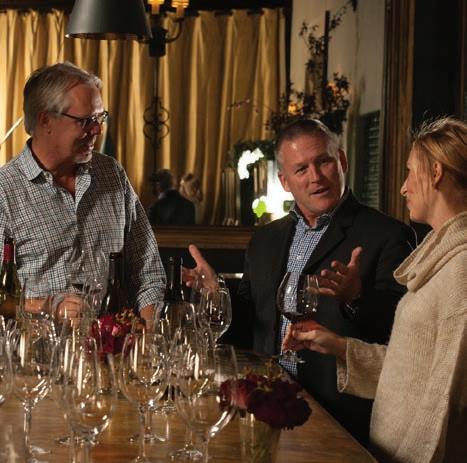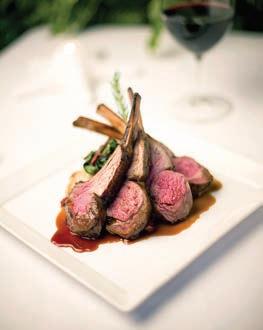
7 minute read
GRAPE Tales, Tributes And All Things
Santa Barbara restaurateurs and business partners Doug Margerum (Wine Cask) and Mitchell Sjerven (Wine Cask and bouchon) have sniffed, swirled, sipped and imbibed perhaps 20,000 bottles of wine over the years.
Doug Margerum opened Wine Cask in 1981 and over the ensuing decades he moved and expanded the restaurant while creating his own eponymous wine label. He also consults with a variety of vineyard owners and wineries with tasting rooms, including his own, showcased in El Paseo Wine Collection.
Mitchell Sjerven celebrates his 20th anniversary as a restaurateur this year (he opened Meritage in 1996). He opened bouchon in 1998 – and joined forces with Doug as Managing partner at the Wine Cask in 2009. His passion lies in providing an authentic, regional dining experience. Mitchell graduated the University of California, Santa Barbara with a degree in International Relations, Political Science and and is a member of the School of Culinary Arts faculty at Santa Barbara City College.
The dynamic duo with a passion for great food and wine kindly agreed to answer some questions about their individual wine trails – as well as how they merged onto a road taken.
LAW: How did you get interested in the noble grape?
Doug: When I was 14, my parents dragged me along on a European vacation (nine countries, six days). My dour mood as a typical, obstinate, pimply-faced adolescent changed as we entered a winery cellar deep in the hills of the famed vineyards of Châteauneuf-du-Pape. I was given a shallow silver cup known as a “tastevin”. It was then, and there, that I became what is affectionately known as a “wine geek”. After the trip, I started collecting wine that I was allowed to open and share with family at holiday meals.
Mitchell: My interest in wine began at an early age, working with Italian and South African wines at a resort with a decent wine list. I fell in love at first sip n’ sight. Most influential at the outset of my career was working at Wine Cask in the early 1990s as head server.
LAW: Mitchell, did you drink wine w/your families growing up?
Mitchell: My parents rarely drank and then on special occasions, like New Year’s Eve. Mom would do “Italian Night” and cook a sad, Middle American version of spaghetti dinner, complete with the green shaker can of Kraft Parmesan cheese and Wonder Bread™ garlic bread. They’d also pull out the open leftover bottle of Mogen David from the previous month’s Italian Night. Eventually, they leaned to appreciate wine from me.
LAW: Was there a “aha moment” for you?
Doug: I’ve had many! Château Climens with seared foie gras, 1977 Dow’s Vintage Port with Stilton cheese and roasted walnuts, a 1973 Dom Perignon, with someone special. My life with wines has been filled with “aha moments”.
LAW: What are some of the highlights of your many years of learning about wines?
Doug: The wine business leads one to extraor- dinary places, with wonderful people and great meals. Most of our business is done at the table drinking wine and enjoying appropriate cuisine.
Mitchell: Many! A pivotal period in time for me was my final semester at UCSB (Class of 1990, International Relations degree), which I did abroad as an intern at the European Parliament in Brussels in 1989. Many nights with Belgian Ale (Orval, Chimay and Duvel became and remain all-time favorites) and moules + frites was a ton of fun. More impactful, I had a few rare opportunities to experience serious cuisine and fell in love with the flavors of classic Francophone gastronomy. Along the way I enjoyed many French wines. The temptation is to point to an obscure, hipster choice of wine, but honestly, it was a bottle of 1985 Lynch Bages that made me pause and take notice that wine could be a very serious, amazing, and conversationworthy matter.
LAW: How do you know what wine to recommend to a customer?
Doug: I ask a customer what wine they would like and then I find something better and less expensive, that they have never heard of before.
Mitchell: By determining the client’s comfort level, familiarity with the wine list and anticipated outcome. We have customers ranging from those who want just a glass of wine to those that are looking to make memories over a special bottle. Others want to try something totally different; some prefer the familiarity of a recognizable, had-it-before, home-run wine. The task of the server or Sommelier is to determine what experience the guest is after and match as best we can, using our experience and familiarity with the menu to guide them to a successful selection.









LAW: What changes have you seen in the wine making/selling/ buying industry over the years?
Doug: #1. Wine has gotten better – when I started in the business there was a lot of seriously flawed wine out there. #2 The Internet has made discovering wine and learning about wine easier. #3 Two-buck Chuck actually got people into drinking wine. #4 People want to know who made their wine.
Mitchell: One of my favorite evolutions in the business over just the past five to ten years is how Santa Barbara has evolved into a bona fide wine region, legitimizing an incredibly sexy industry in our backyard in a way that resonates with younger, newer wine audiences who are not hung up on convention, but rather simply want to learn.
LAW: How important are wine reps to you?
Mitchell: Wine reps are critically important, as they are the vanguard of new releases. We rely on them to keep us apprised of availability and special pricing.

LAW: Do you drink wine every day of the week?
Doug: I try and take a couple days off a week.
Mitchell: Of course!
LAW: What have you learned that has surprised you the most?
Doug: Sommeliers know wine and understand how the components of wine can act in unison to complement and enhance the dining experience. Many times we think their role is to know and recall details of every producer and region around the world. Although some can do that, their role in a restaurant is to pair food and wine—specifically the cuisine of that restaurant with wines they have personally curated.
LAW: What have you learned that you wish you’d know sooner?
Doug: After hundreds of visits to wineries throughout the world, after countless “wine experiences”, and after scores of dinners matching wine and food worldwide, it became time to choose that one varietal for making wine. I choose Syrah. Syrah manifests itself in so many ways. I like the many moods of Syrah – it can be dark and brooding, light and fruity, or tannic and strong. Syrah is always expressive by itself, and it is great with highly flavored foods. Syrah is the quintessential grilled foods wine. The peppery qualities pair well with smoke, wood, and char.
LAW: What have you learned that you wish everyone else would learn/acknowledge?
Doug: Wine should be fun! If a red wine is served hot it is okay to put some ice in it. The wine will taste better. If it’s an expensive red wine served to you at a high-class restaurant –then return it – it is not acceptable to drink it hot or to put ice in it. A simple Pinot Grigio served warm at a picnic? Add ice. A Montrachet? No ice.
Also, proper stemware is the first step towards improving any wine experience. Stemware quality has a tremendous impact on the enjoyment of wine. Restaurants and homes across this great land of ours do not seem to realize this. Even ordinary wines taste more stylish and superior when served in suitable stemware.
Mitchell: In the U.S., we define our wines by the grape used to produce the wine, but in Europe the wine is defined by the region where it is produced. It would truly help most American wine consumers if they were to understand Burgundy = Chardonnay for white, Pinot Noir for red. Bordeaux = Cabernet, Merlot and a few other red varietals; and mostly Sauvignon Blanc for white wine.
LAW: How important is wine pairing with food? Any tricks of the trade?
Mitchell: But, that being said, most good, dry wine goes with most food. Low alcohol wine is best with spicy food (high alcohol wines exacerbate the heat). Crisp, acidic whites pair with just about anything. High tannin reds suit fatty, red meats very well. Sweet wines go well with rich, savory chilled meats like pate´, charcuterie. I like to show off local Syrah blends for Cabernet lovers that don’t know Santa Barbara wines. For indecisive guests, offer a stainless vs. an oaked Chardonnay to elicit a ‘wow’ emotion.
LAW: How much is too much wine over the course of a meal/ evening?
Doug: Do not drink too much. Getting drunk is the worst breech of etiquette. At a dinner party, where many wines are being served, it is not necessary to finish every glass of wine that is poured. Monitor your consumption, drink more water than wine, and eat.
Mitchell: I believe it’s difficult to retain more than seven or eight wines worth of tasting information. Further, over consuming is a very personal thing. The amount is related to both length of dining experience, weight of the individual and quantity of food consumed, etc. Moderation as a rule is positively the best idea—you want to be able to enjoy the finer things in life, without having to ask yourself the next day if you have a problem. That said, my birthday is Cinco de Mayo, so I enjoy plenty of fine tequila, but am with friends and don’t drive.
LAW: How do you feel about people who bring their own bottle?
Mitchell: No problem. That’s why we charge a corkage fee.
LAW: On B.Y.O.B., should they share a taste with their server?

Mitchell: Mixed feelings. It’s impossible to distinguish between generosity, and an attempt to circumvent the corkage fee. Most guests who share a taste of their BYOB wine except to have the corkage fee waived. Contrary—still—to popular
(continued on page 86)











